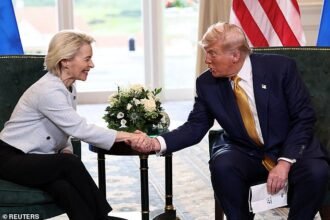EUR/USD edges higher toward 1.1600 in the European morning on Wednesday but doesn’t yet point to an increasing buyer interest. Later in the American session, the minutes of the Federal Reserve’s (Fed) October policy meeting and Nvidia’s third-quarter earnings report could provide a directional catalyst for the pair.
Euro Price This week
The table below shows the percentage change of Euro (EUR) against listed major currencies this week. Euro was the weakest against the Canadian Dollar.
| USD | EUR | GBP | JPY | CAD | AUD | NZD | CHF | |
|---|---|---|---|---|---|---|---|---|
| USD | 0.42% | 0.22% | 0.70% | -0.14% | 0.84% | 0.87% | 0.73% | |
| EUR | -0.42% | -0.08% | 0.67% | -0.53% | 0.41% | 0.48% | 0.34% | |
| GBP | -0.22% | 0.08% | 0.49% | -0.45% | 0.50% | 0.56% | 0.42% | |
| JPY | -0.70% | -0.67% | -0.49% | -0.82% | 0.14% | 0.16% | 0.00% | |
| CAD | 0.14% | 0.53% | 0.45% | 0.82% | 0.97% | 1.00% | 0.88% | |
| AUD | -0.84% | -0.41% | -0.50% | -0.14% | -0.97% | 0.06% | -0.07% | |
| NZD | -0.87% | -0.48% | -0.56% | -0.16% | -1.00% | -0.06% | -0.13% | |
| CHF | -0.73% | -0.34% | -0.42% | -0.00% | -0.88% | 0.07% | 0.13% |
The heat map shows percentage changes of major currencies against each other. The base currency is picked from the left column, while the quote currency is picked from the top row. For example, if you pick the Euro from the left column and move along the horizontal line to the US Dollar, the percentage change displayed in the box will represent EUR (base)/USD (quote).
Safe-haven flows continued to dominate the action in financial markets on Tuesday after Wall Street’s main indexes opened deep in negative territory. In turn, the US Dollar (USD) preserved its strength and caused EUR/USD to stretch lower.
Early Wednesday, US stock index futures trade marginally higher, helping EUR/USD keep its footing.
FOMC Minutes will be scrutinized by market participants for clues on whether the US central bank is likely to cut the policy rate against in December.
In case the publication shows that policymakers are growing increasingly worried about the labor market, the immediate reaction could hurt the USD. On the flip side, investors could scale back bets on a December rate cut if Fed officials hint that they could stay on hold while waiting for the data backlog, caused by the record-long US government shutdown, to clear. In this scenario, EUR/USD could stretch lower. According to the CME FedWatch Tool, markets are currently pricing in about a 50% chance of a 25 basis point (bps) rate cut in December.
Meanwhile, markets could turn cautious while waiting for Nvidia’s earnings after the closing bell and support the USD.
EUR/USD Technical Analysis:
In the 4-hour chart, the 20-period Simple Moving Average (SMA) and the 200-period SMA stay near 1.1600, while price holds beneath both. The 50-period SMA rises and stands above the 100-period one, as the pair remains over these mid-term averages. The 14-period Relative Strength Index (RSI) sits at 50, neutral, after a modest recovery from mid-40s. Measured from the 1.1885 high to the 1.1470 low, the 38.2% retracement at 1.1628 caps near-term rebounds, with the 50% at 1.1678 as the next resistance.
Tactical bias is mixed, given the split between short- and long-term averages and momentum that is stabilizing rather than building. Static support levels are seen at 1.1567 (Fibonacci 23.6% retracement) then at 1.1450. A move back above the 200-period SMA would improve the tone, while failure to reclaim it could keep EUR/USD contained within a tight 4-hour range.
(The technical analysis of this story was written with the help of an AI tool)
Euro FAQs
The Euro is the currency for the 20 European Union countries that belong to the Eurozone. It is the second most heavily traded currency in the world behind the US Dollar. In 2022, it accounted for 31% of all foreign exchange transactions, with an average daily turnover of over $2.2 trillion a day.
EUR/USD is the most heavily traded currency pair in the world, accounting for an estimated 30% off all transactions, followed by EUR/JPY (4%), EUR/GBP (3%) and EUR/AUD (2%).
The European Central Bank (ECB) in Frankfurt, Germany, is the reserve bank for the Eurozone. The ECB sets interest rates and manages monetary policy.
The ECB’s primary mandate is to maintain price stability, which means either controlling inflation or stimulating growth. Its primary tool is the raising or lowering of interest rates. Relatively high interest rates – or the expectation of higher rates – will usually benefit the Euro and vice versa.
The ECB Governing Council makes monetary policy decisions at meetings held eight times a year. Decisions are made by heads of the Eurozone national banks and six permanent members, including the President of the ECB, Christine Lagarde.
Eurozone inflation data, measured by the Harmonized Index of Consumer Prices (HICP), is an important econometric for the Euro. If inflation rises more than expected, especially if above the ECB’s 2% target, it obliges the ECB to raise interest rates to bring it back under control.
Relatively high interest rates compared to its counterparts will usually benefit the Euro, as it makes the region more attractive as a place for global investors to park their money.
Data releases gauge the health of the economy and can impact on the Euro. Indicators such as GDP, Manufacturing and Services PMIs, employment, and consumer sentiment surveys can all influence the direction of the single currency.
A strong economy is good for the Euro. Not only does it attract more foreign investment but it may encourage the ECB to put up interest rates, which will directly strengthen the Euro. Otherwise, if economic data is weak, the Euro is likely to fall.
Economic data for the four largest economies in the euro area (Germany, France, Italy and Spain) are especially significant, as they account for 75% of the Eurozone’s economy.
Another significant data release for the Euro is the Trade Balance. This indicator measures the difference between what a country earns from its exports and what it spends on imports over a given period.
If a country produces highly sought after exports then its currency will gain in value purely from the extra demand created from foreign buyers seeking to purchase these goods. Therefore, a positive net Trade Balance strengthens a currency and vice versa for a negative balance.




















